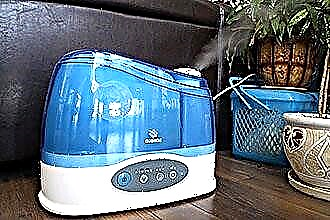High blood pressure is often the result of stress or overwork. If the case is an isolated one, then it will be enough for a person to rest. Sometimes you can take a sedative drug to calm yourself down. If blood pressure rises at a temperature, then this may indicate not only a cold, but also the presence of serious health problems. They can be dealt with if the examination is completed in a timely manner and the course of treatment is started.
 Body temperature should normally be 36.6 °. If there is a deviation in the direction of decrease or increase, then there are many reasons for this phenomenon, for example, infection or neoplasm. With hypertension, an increase in temperature causes a much narrower range of pathological processes.
Body temperature should normally be 36.6 °. If there is a deviation in the direction of decrease or increase, then there are many reasons for this phenomenon, for example, infection or neoplasm. With hypertension, an increase in temperature causes a much narrower range of pathological processes.
Most often, high blood pressure and a temperature of 37 ° are the result of endocrine disruptions.
The essence of the problem in this case is to change the hormonal balance. Increased or decreased body temperature with arterial pressure can be against the background of failures in the autonomic division of the central nervous system. Sometimes, along with them, a person develops a panic attack.
In general, hypertension and high temperature are combined mainly in the following cases:
- cold;
- pheochromocytoma;
- malfunctioning of the kidneys;
- thyrotoxic crisis;
- vegetative crisis.
Cold
An increase in blood pressure and temperature can occur due to a common cold. In this case, the reasons for the development are as follows:
- Against the background of the development of infection in the body, the tone of the sympathetic part of the autonomic nervous system may increase and the pressure may increase.
- Due to illness, a person's temperature rises as a result of the body's fight against infection, and against this background stress arises, which is the main cause of arterial hypertension.
- Medicines that reduce fever and other manifestations of the disease often have a vasoconstrictor effect. Due to their use, blood pressure can rise. This reason is often the result of self-treatment for the common cold. The most dangerous substance for hypertensive patients is phenylephrine. It is included in most cold medicines that are taken if the temperature rises.
Exposure to the sympathetic nervous system, stress and misuse of medications are the main causes of high blood pressure in colds.
You can prevent their occurrence, but for this you should contact a therapist at your place of residence in a timely manner. The doctor will recommend medications, focusing on the individual characteristics of the patient, especially in the presence of hypertension.
Pheochromocytoma
Temperature at elevated pressure can be a sign of the appearance of a neoplasm in the body, for example, pheochromocytoma. In most cases, it is found in and around the adrenal glands. By its nature, pheochromocytoma is either benign or malignant. It consists mainly of neuroendocrine cells. A persistent increase in pressure against a background of high temperature (38 ° and more) is one of the main signs of pheochromocytoma. Despite this, it is extremely difficult to identify it, since the neoplasm is disguised as many other diseases.
The tumor is manifested by arterial hypertension and high fever due to the excessive production of catecholomines, namely adrenaline, nanoadrenaline and dopamine. This condition is called paroxysm, that is, an increase in any pathological process to the highest point or a catecholamine crisis. It can be activated at any time, for example, during mental or physical exertion, during fasting or eating. In severe cases, the crisis manifests itself even with a change in body position and after stress.
If the pheochromocytoma grows in the bladder, then an attack of paroxysm may occur during urination. Sometimes the tumor manifests itself only in high pressure, and other symptoms are mild or completely absent. Due to hormonal surges, crises often occur in pregnant women.
Pheochromocytoma can be suspected by other signs:
- fog in front of the eyes and split images;

- the emergence of uncontrolled and unreasonable fear;
- headache;
- angina pectoris;
- pain in the abdomen;
- arrhythmia;
- increased breathing;
- blanching of the skin;
- nausea up to vomiting.
The catecholamine crisis lasts mainly up to 4-5 minutes, but in severe cases the condition can stabilize within half an hour. An attack occurs and passes suddenly and the patient, in general, does not have time to take any medication.
To reduce the manifestations of the crisis, alpha and beta-blockers ("Tropafen", "Labetalol") are used. You can completely get rid of pheochromocytoma only by surgery.
Disruption of kidney function
Arterial hypertension is sometimes observed with narrowing of the renal artery. The kidney begins to lack nutrition and the process of slowing down the excretion of fluid is activated. Against this background, pressure rises and body temperature rises.
Treatment in this case consists in the use of antihypertensive and diuretic drugs like "Indapamide". However, without accurate diagnostics, the problem will not be solved. Your doctor will recommend tests to find the narrowing and the cause.
If the problem lies in the compression of the tissue by the tumor, then an operation to remove it will be required. In other cases, the vessel is expanded surgically.
After eliminating the cause of the narrowing, pressure and temperature return to normal.
Thyrotoxic crisis
Thyroid hormones stimulate the growth and development of the body, but if they are excessively synthesized, a thyrotoxic crisis can occur. In humans, this increases the concentration of thyroxine and triiodothyronine in the blood, and also increases the pressure and body temperature.
You can also identify the disease by other symptoms, namely:
- overexcitation of the nervous system;
- weakening of muscle tissue;
- severe tremor (trembling);
- increased heart rate;
- shortness of breath;
- atrial fibrillation;
- upset stool;
- vomit;
- pain in the stomach.
Thyrotoxic crisis often occurs after surgery on the thyroid gland. Symptoms progress especially quickly after the removal of a toxic goiter. Among other factors in the development of a crisis, pregnancy, infections and injuries can be distinguished.
Treatment will require oxygen therapy, since thyroid hormones greatly increase the tissue oxygen demand. No less important is drug treatment, which includes the following groups of drugs:
- thyreostatics ("Mercazolil");
- tranquilizers ("Phenazepam", "Mesapam");
- antipyretic drugs ("Paracetomol");
- beta-blockers ("Atenol", "Betoptic").
Vegetative crisis
Failures in the autonomic part of the nervous system often lead to the appearance of various symptoms, including an increase or decrease in body temperature and pressure surges.
The most unpleasant manifestations are vegetative crises. They represent paroxysms of dysfunction of the autonomic nervous system.
Changes in temperature and pressure are often combined during a panic attack. In addition to them, other symptoms are characteristic of this manifestation of a vegetative crisis:
- general weakness;
- lack of oxygen;
- nausea;
- increased heart rate;
- chest pain;
- excessive sweating;
- loss of control over fear;
- uncontrolled urination and defecation;
- fear of death;
- palpitations;
- abdominal pain.
The attack can last from 2-3 minutes to half an hour. Taking medication at this time is useless, since the panic attack ends mostly earlier. The essence of the treatment consists in correcting the lifestyle, taking sedatives and a course of psychotherapy.
The combination of fever and pressure may be due to inappropriate medication during the treatment of a cold. However, sometimes such symptoms indicate serious pathological processes developing in the body. In such a situation, it will be necessary to urgently undergo an examination and begin treatment in order to avoid complications.




